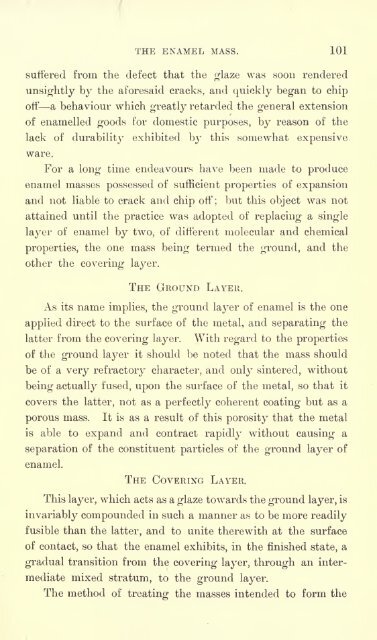Enamels and enamelling; an introduction to the preparation and ...
Enamels and enamelling; an introduction to the preparation and ...
Enamels and enamelling; an introduction to the preparation and ...
You also want an ePaper? Increase the reach of your titles
YUMPU automatically turns print PDFs into web optimized ePapers that Google loves.
THE ENAMEL MASS. 101<br />
suffered from <strong>the</strong> defect that <strong>the</strong> glaze was soon rendered<br />
unsightly by <strong>the</strong> aforesaid cracks, <strong><strong>an</strong>d</strong> quickly beg<strong>an</strong> <strong>to</strong> chip<br />
off a behaviour which greatly retarded <strong>the</strong> general extension<br />
of enamelled goods for domestic purposes, by reason of <strong>the</strong><br />
lack of durability exhibited by this somewhat expensive<br />
ware.<br />
For a long time endeavours have been made <strong>to</strong> produce<br />
enamel masses possessed of sufficient properties of exp<strong>an</strong>sion<br />
<strong><strong>an</strong>d</strong> not liable <strong>to</strong> crack <strong><strong>an</strong>d</strong> chip off; but this object was not<br />
attained until <strong>the</strong> practice was adopted of replacing a single<br />
layer of enamel by two, of different molecular <strong><strong>an</strong>d</strong> chemical<br />
properties, <strong>the</strong> one mass being termed <strong>the</strong> ground, <strong><strong>an</strong>d</strong> <strong>the</strong><br />
o<strong>the</strong>r <strong>the</strong> covering layer.<br />
THE GROUND LAYER.<br />
As its name implies, <strong>the</strong> ground layer of enamel is <strong>the</strong> one<br />
applied direct <strong>to</strong> <strong>the</strong> surface of <strong>the</strong> metal, <strong><strong>an</strong>d</strong> separating <strong>the</strong><br />
latter from <strong>the</strong> covering layer. With regard <strong>to</strong> <strong>the</strong> properties<br />
of <strong>the</strong> ground layer it should be noted that <strong>the</strong> mass should<br />
be of a very refrac<strong>to</strong>ry character, <strong><strong>an</strong>d</strong> only sintered, without<br />
being actually fused, upon <strong>the</strong> surface of <strong>the</strong> metal, so that it<br />
covers <strong>the</strong> latter, not as a perfectly coherent coating but as a<br />
porous mass. It is as a result of this porosity<br />
that <strong>the</strong> metal<br />
is able <strong>to</strong> exp<strong><strong>an</strong>d</strong> <strong><strong>an</strong>d</strong> contract rapidly without causing a<br />
separation of <strong>the</strong> constituent particles of <strong>the</strong> ground layer of<br />
enamel.<br />
THE COVERING LAYER.<br />
This layer, which acts as a glaze <strong>to</strong>wards <strong>the</strong> ground layer, is<br />
invariably compounded in such a m<strong>an</strong>ner as <strong>to</strong> be more readily<br />
fusible th<strong>an</strong> <strong>the</strong> latter, <strong><strong>an</strong>d</strong> <strong>to</strong> unite <strong>the</strong>rewith at <strong>the</strong> surface<br />
of contact, so that <strong>the</strong> enamel exhibits, in <strong>the</strong> finished state, a<br />
gradual tr<strong>an</strong>sition from <strong>the</strong> covering layer, through <strong>an</strong> intermediate<br />
mixed stratum, <strong>to</strong> <strong>the</strong> ground layer.<br />
The method of treating <strong>the</strong> masses intended <strong>to</strong> form <strong>the</strong>
















